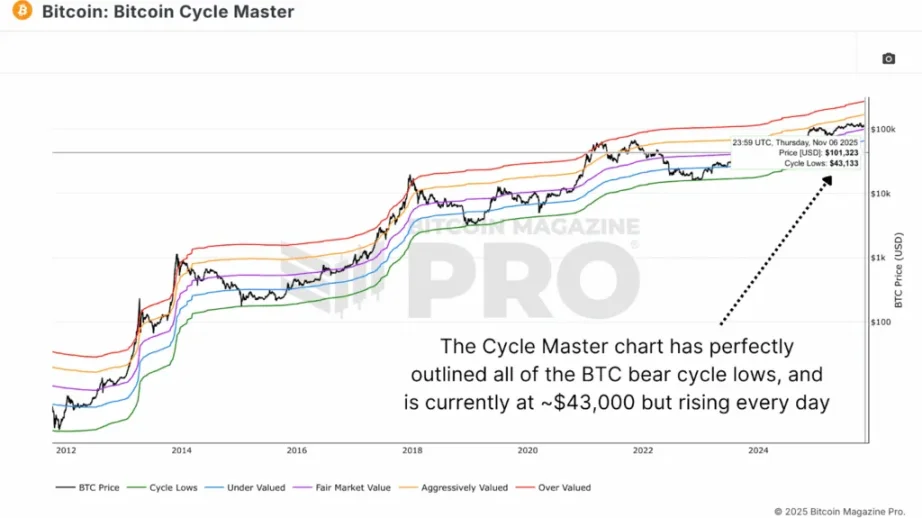20x in 3 months, is the ZEC $10,000 prophecy coming true?
Source: BlockBeats
Original Title: 20x in 3 Months—Does ZEC's "Bitcoin Silver" Narrative Hold Water?
The crypto-punk pursuit of privacy can be traced back 16 years to the birth of Bitcoin, which embedded privacy mechanisms into a fully transparent ledger, thus launching the entire cryptocurrency world. To this day, privacy remains a key topic in the crypto space.
If you bought and held ZEC from the first time this cycle’s “Version Child” Mert called it, you would have achieved a rare 20x return among altcoins in less than three months this year.
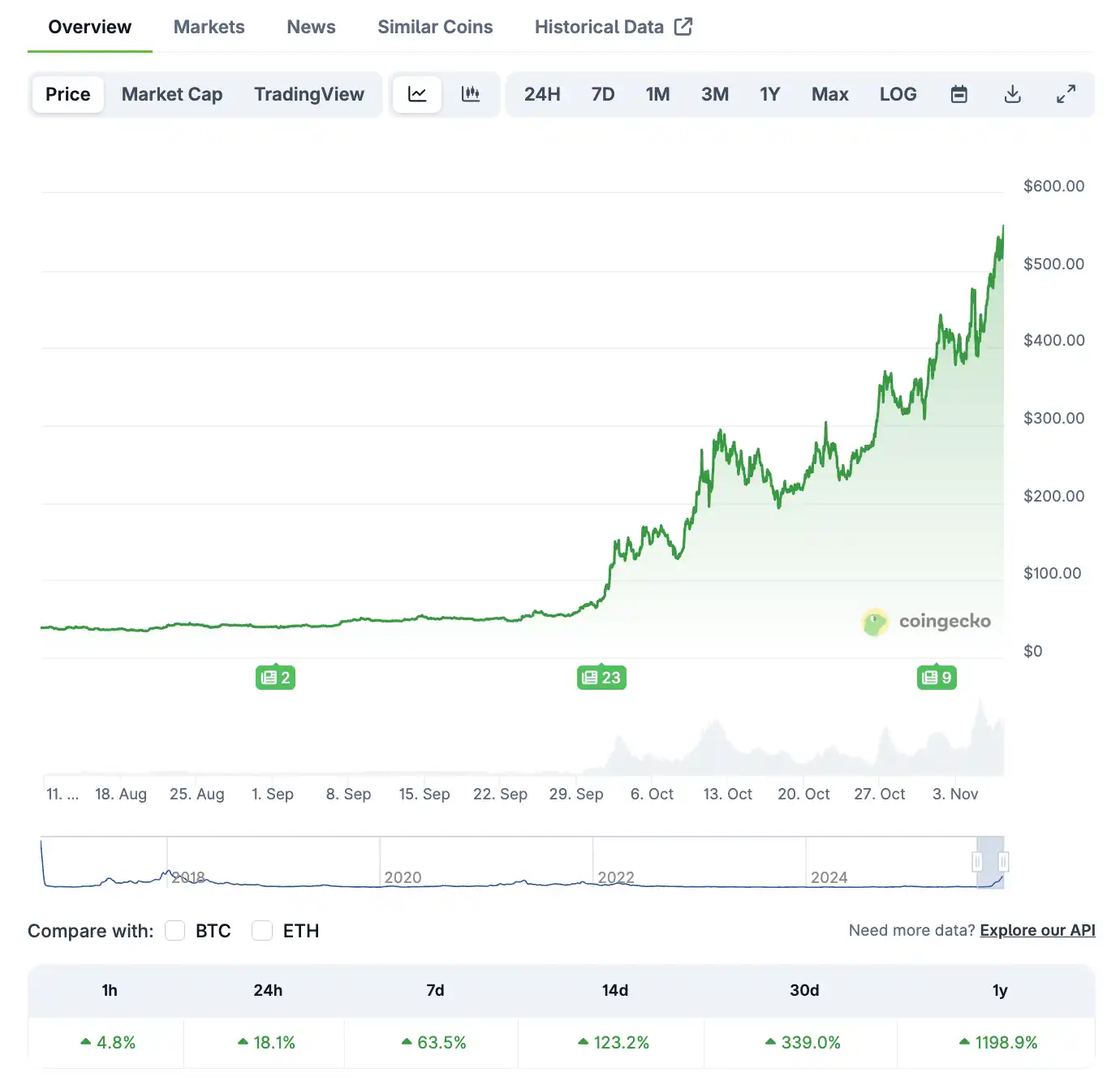
When ZEC soared from $238 to $580 in 40 days, marking a 20x increase in three months and hitting a seven-year high, the crypto market realized that a long-forgotten sector was making a strong comeback. The entire privacy coin sector surged about 80% in the past 7 days, with veteran projects like DASH, DCR, and ZEN rising over 100%.
Even more surprising was the shift in market sentiment. Just a few months ago, privacy coins were labeled as “regulatory orphans”—Kraken delisted XMR, and the EU’s 2027 ban proposal made investors avoid them. But now, “Privacy is a necessity, not a feature” has become a high-frequency topic on Twitter, Arthur Hayes publicly declared “ZEC target $10,000,” and Vitalik has repeatedly endorsed ZKsync.
What is the real driving force behind this rally? Is it a flight to safety under regulatory pressure, or pure capital speculation?
More importantly, how long can this hype last?
Who’s Leading the Rally?
ZEC is undoubtedly the absolute leader of this cycle. Starting at $237.84 on October 23 and reaching $532.06 on November 7, it rose 120% in 40 days, with a cumulative annual increase of 700%. This price not only set a new high since 2018 but also brought ZEC back into the mainstream investor spotlight.
Looking back at several key moments, ZEC’s upward trajectory is clear:
October 1: Grayscale announced the reopening of the ZEC Trust (ZCSH), offering fee waivers and staking features. ZEC surged 22% that day;
October 24: A “flag breakout” technical pattern appeared, with on-chain indicators OBV and CMF rising in tandem, resulting in a 40% increase in 4 days;
November 1: Futures open interest (OI) broke $770 million for the first time, Arthur Hayes again called for a “$10,000 target,” triggering a short squeeze and a 15% daily gain;
November 7: Price broke $532, with 24-hour spot trading volume reaching $1.75 billion, 1.4 times the monthly average;
More noteworthy is the fundamental improvement: ZEC’s shielded pool balance surpassed 5 million coins for the first time, accounting for about 30% of circulation—equivalent to $2.5 billion stored fully anonymously. Daily transaction volume rose from 10,000 to 12,600, with the proportion of shielded transactions jumping from under 10% to 25-30%. These figures show ZEC’s rise is not pure speculation but supported by real privacy demand.
ZEC’s strong performance ignited the entire privacy sector, with a batch of previously forgotten veteran projects also exploding:
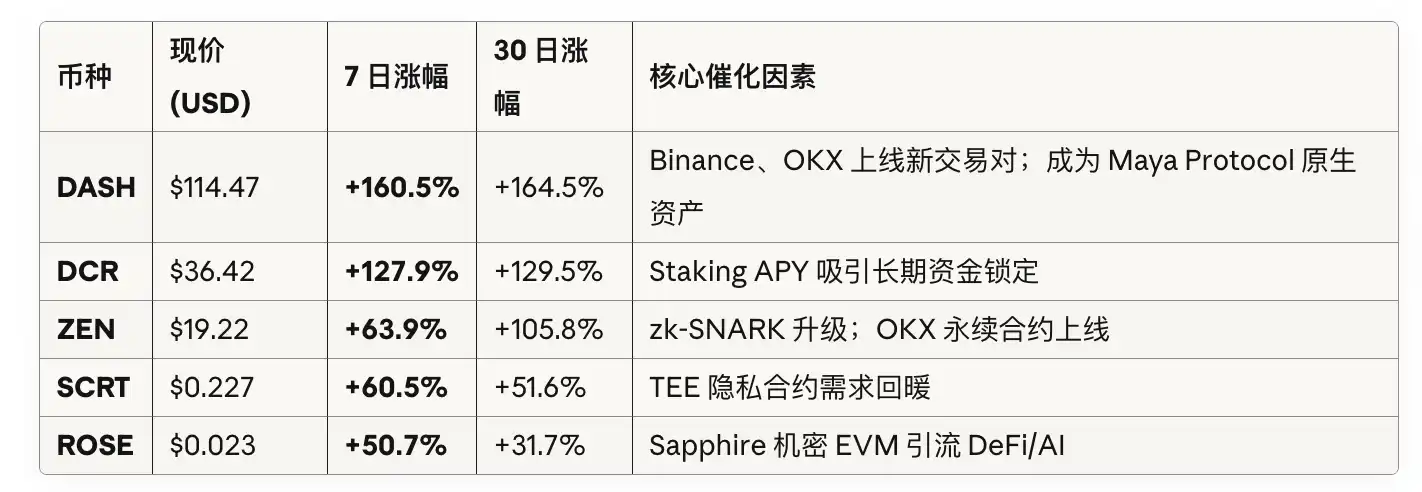
There are two key drivers behind this collective surge:
First is the concentrated listing of new products on exchanges. From November 2-6, Binance, OKX, and Bitget successively launched perpetual contracts or new spot pairs for DASH, ZEN, and SCRT, bringing not only increased liquidity but also the amplifying effect of high-leverage derivatives. For example, DASH’s 24-hour spot plus contract trading volume exceeded $1.2 billion, a 2.8x increase from the previous period.
Second is substantial technical or protocol progress. On November 2, DASH became a native asset of Maya Protocol, enabling cross-chain anonymous swaps; ZEN completed migration to Base L2, doubling zk-SNARK efficiency; SCRT and ROSE benefited from the new narrative of privacy computing combined with AI.
In addition, there is a special player in the privacy sector: ZKsync (ZK).
Technically, ZK is an Ethereum Layer-2 scaling solution, with transactions on the main chain still transparent; but due to its optional ZK privacy features and Prividium enterprise private chain, mainstream platforms like CoinGecko and Santiment classify it as part of the privacy sector.
In the past 7 days, ZK has risen over 130%, making it one of the top gainers in the privacy track. Three catalysts are behind this performance:
Atlas upgrade performance leap: The Atlas upgrade, fully activated on November 1, increased theoretical TPS from 2,000 to 15,000-30,000, reduced ZK finality from 3 hours to 1 second, and dropped per-transaction fees from $0.0013 to below $0.0001. Previously, ZK’s biggest limitation was higher fees compared to OP, but the Atlas upgrade has greatly improved this.
Tokenomics overhaul: The “ZKnomics Part I” proposal announced on November 4 for the first time redirected network transaction and enterprise authorization fees back to the Treasury for “buyback-burn + staking dividends,” transforming ZK from a pure governance token to a cash-flow asset. Estimated staking APY could reach 8-12%.
Vitalik’s public endorsement: On November 1, Vitalik posted two tweets saying ZKsync is “undervalued,” causing ZK’s trading volume to surge 30x that day. Endorsement from a core figure played a key catalytic role in market sentiment.
What’s the Logic Behind the Privacy Narrative Rally?
“Safe Haven Premium” Under Regulation
On the surface, tighter regulation should suppress privacy coins, but in reality, it is precisely regulatory pressure that has stimulated privacy demand.
Policy tightening is accelerating. The EU’s Anti-Money Laundering Regulation (AMLR) draft clearly proposes to completely restrict privacy coin trading within the EU by 2027; the US Financial Crimes Enforcement Network (FinCEN) also plans to increase scrutiny of “high-risk self-custody addresses.” With Bitcoin and Ethereum spot ETFs entering the regulatory spotlight, all on-chain transactions face stricter tracking.
As compliant assets become more transparent, privacy assets become scarce.
Thus, Western media have even named this rally the “Crypto Anti-Surveillance Wave.” ZEC and XMR are being redefined as “the last line of defense for on-chain anonymity.” Social media consensus is even more direct: “Privacy is not a feature, but a basic right.”
On-chain data confirms the growth in real demand.
ZEC’s shielded pool balance grew from 4 million to 4.9 million in 40 days, a 25% increase; the proportion of shielded transactions jumped from under 10% to 25-30%, meaning more users are choosing fully anonymous transactions. The more users, the stronger the privacy guarantee and the more obvious the network effect.
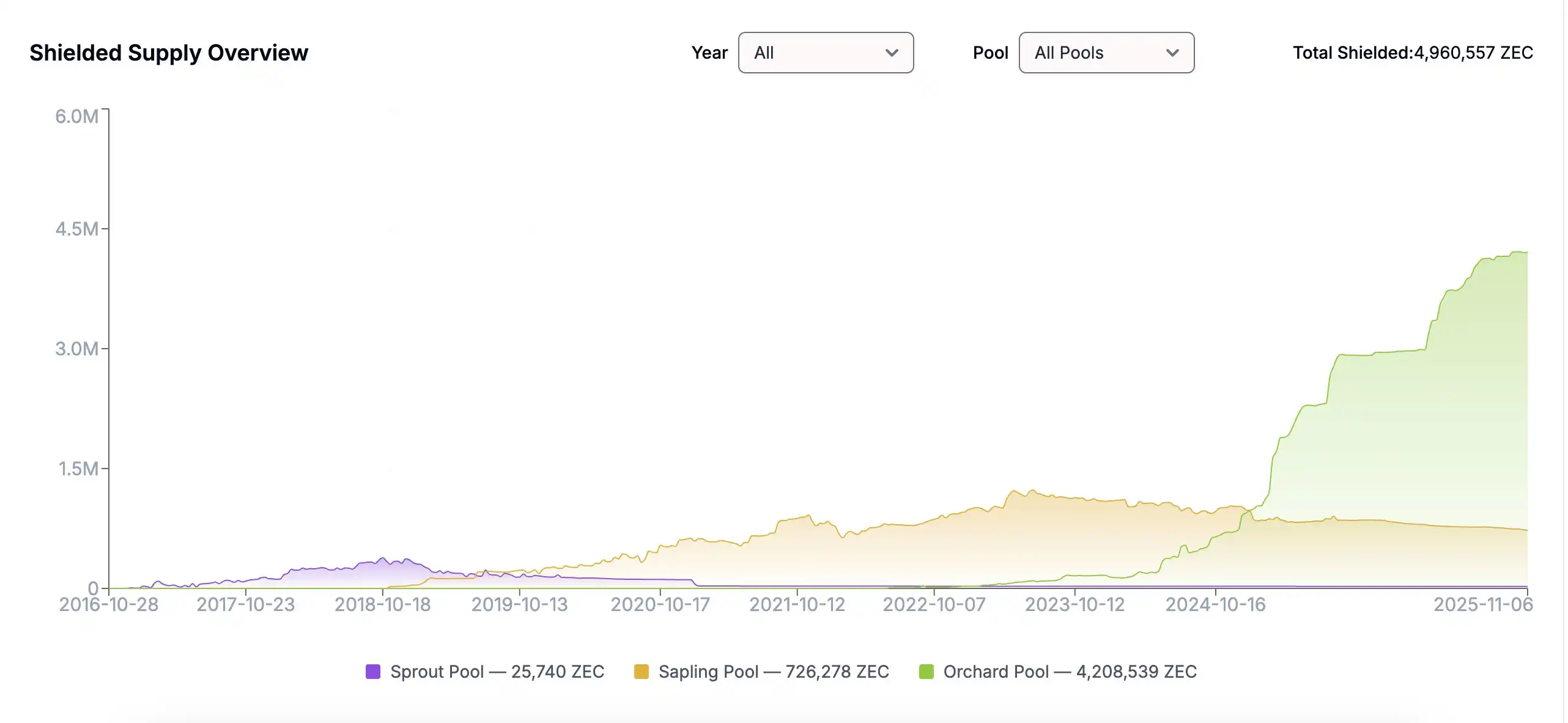
Increased on-chain activity for ZEC, DASH, and ROSE is also strong evidence. ZEC’s daily transaction volume grew from about 10,000 on October 1 to 12,600 on November 7, a 26% increase. DASH’s 30-day average daily on-chain transactions rose 15%, from about 1,300 to 1,500; ROSE surged 200%, from about 3,300 to 10,000.
ZK’s TVL rebound is also noteworthy. After the Atlas upgrade, ZKsync Era’s TVL rose from $500 million to $600 million, a 20% increase—an upward trend against the backdrop of declining TVL across the Layer-2 ecosystem.
Exchange inflow data also reflects a trend of token lock-up. ZEC’s net exchange inflow dropped sharply from $41.8 million to $3.66 million within 48 hours, a 91% decrease. This indicates that holders are not short-term speculators but have long-term confidence in growing privacy demand.
The Grayscale Effect on ZEC
The return of institutional capital is one of the most important catalysts of this rally.
The relaunch of Grayscale’s Grayscale ZEC Trust was the most significant event in October. On October 1, Grayscale announced the reopening of new subscriptions for the ZCSH Trust, with two major upgrades: waiving management fees and adding staking functionality, offering 4-5% annualized returns. This combination greatly improved the risk-reward ratio.
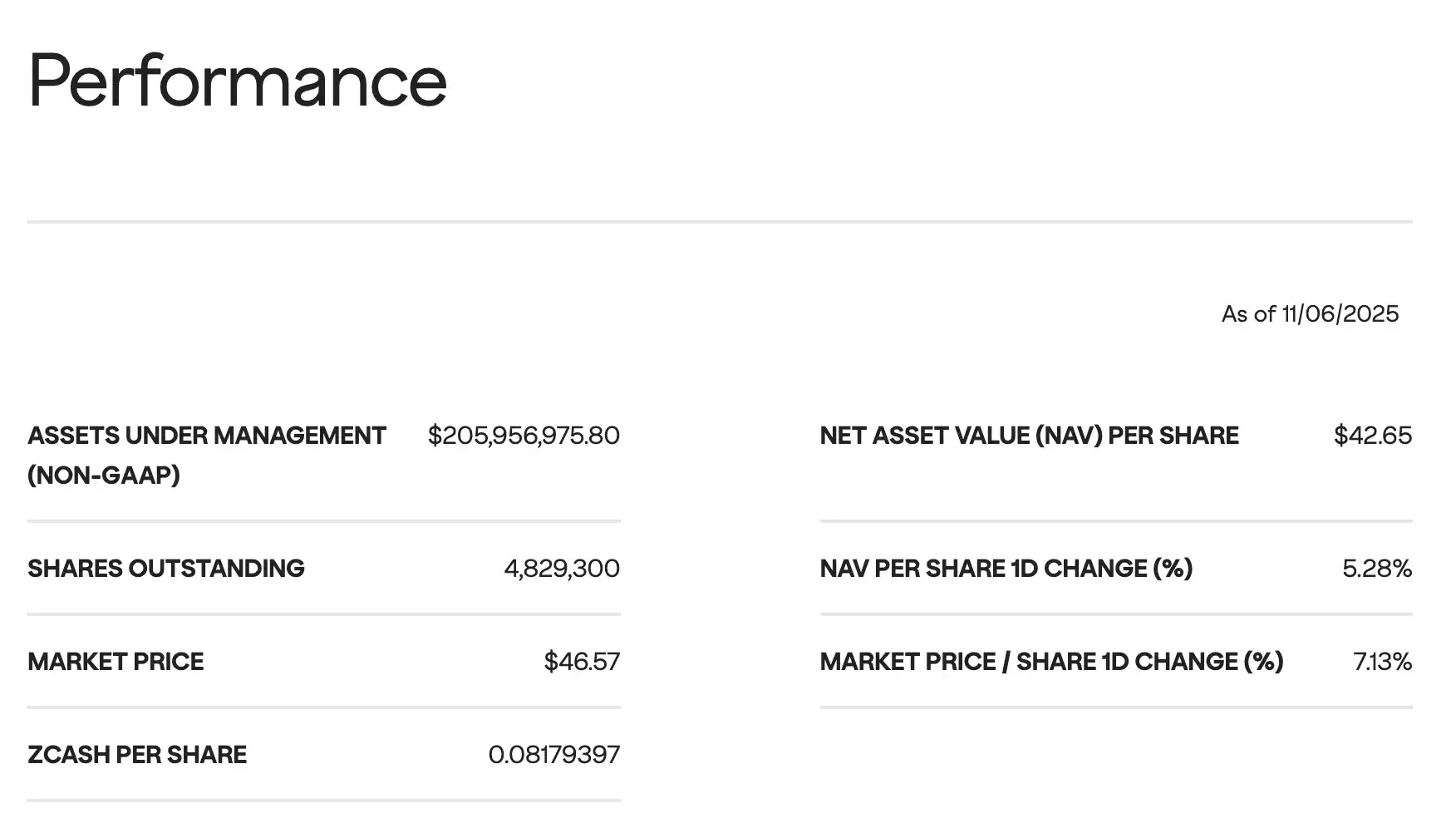
Why does the word “Grayscale” carry so much weight? Because over the past decade, Grayscale has been almost the only compliant bridge and price indicator for traditional institutions allocating crypto assets. Its US-issued trusts have long provided crypto exposure for pensions, family offices, and hedge funds, making it a leading indicator of institutional entry scale and preference changes.
Since launching the first Bitcoin trust in 2013, Grayscale has successively set up single-asset trusts for ETH, SOL, LTC, BCH, ETC, FIL, XLM, and more. Many of these assets have experienced the classic “Grayscale effect”—capital inflows driving price up, premium expansion, and narrative consensus formation. The ZEC Trust (ZCSH) was established as early as 2017 and saw a phase of premium frenzy during the 2020-2021 bull market, becoming a main institutional allocation target in the privacy sector.
However, as regulation tightened and privacy coins faced compliance pressure, ZCSH suspended subscriptions in 2022 and entered a dormant period in 2023. This relaunch means Grayscale is once again endorsing privacy assets, and the signal is even more significant than the capital itself.
Data shows ZCSH’s AUM (assets under management) soared 228% in one month, from about $42 million to $136 million, accounting for about 1.9% of ZEC’s circulating supply. For an asset with daily trading volumes of several hundred million dollars, nearly 2% of tokens being locked long-term in the trust has a significant supply-tightening effect.
At a deeper level, this is the ETF’s indirect effect. The approval of Bitcoin and Ethereum spot ETFs has brought these assets under strict regulatory frameworks, making every transaction traceable. Some institutions and high-net-worth individuals, seeking to avoid such transparency, are shifting funds toward anonymous assets. Grayscale’s ZEC Trust provides a compliant channel—offering privacy coin exposure while operating through traditional financial channels.
The Shared Positions of the Crypto Version Children
Social media has played the role of amplifier in this rally.
During ZEC’s rise, Mert (@0xMert_), regarded as this cycle’s Solana ecosystem “version child,” was undoubtedly one of the most crucial voices behind the price movement.
As CEO of Solana core infrastructure Helius and one of the most recognized voices in the Solana ecosystem, Mert began heavily recommending ZEC at $30 and has continued to promote it daily on X, livestreams, and podcasts. As a result, the ZEC and Solana communities now overlap significantly.
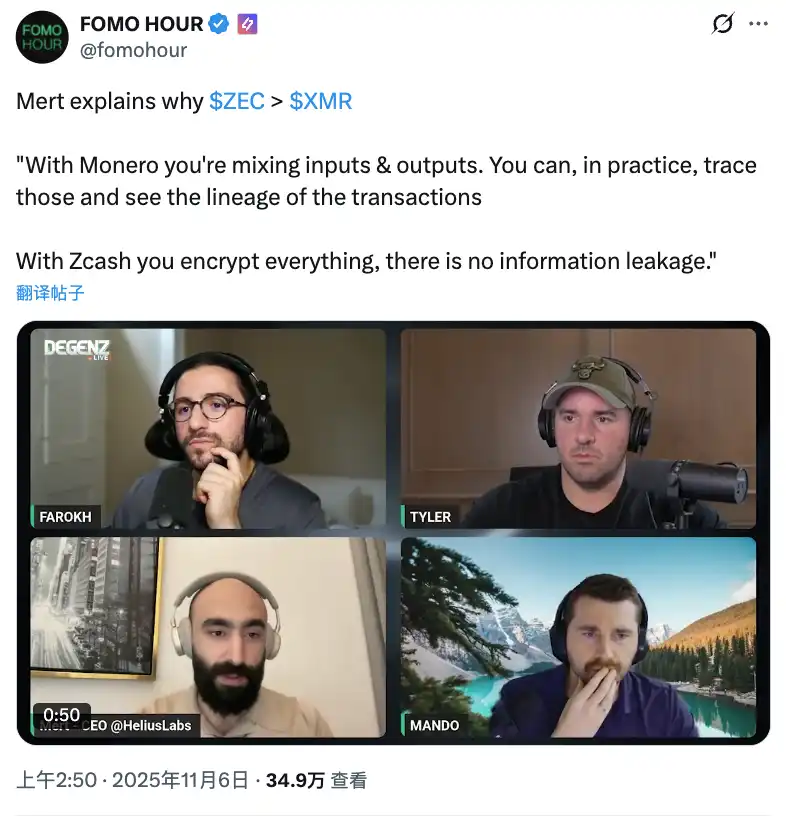
Even more catalytic was Arthur Hayes’s continuous public calls. The BitMEX co-founder was one of the best cycle-turning forecasters in the last bull market. On October 31, he first set a “ZEC target $1,000,” which was already stunning; then on November 1, he directly raised it to a “$10,000 target,” positioning ZEC as a “safe-haven asset in the crypto market.”
This tweet received over 200,000 interactions in a single day, causing ZEC’s trading volume to soar and the price to jump 15% in the short term.
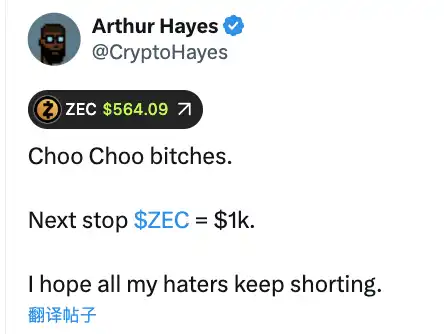
Subsequently, Naval Ravikant’s comments elevated ZEC’s narrative from “speculative asset” to a debate over “values and technological direction.” Naval redefined the value foundation of privacy assets with the phrase, “Privacy is a basic right, not a criminal tool.”
As the “biggest ZK fan,” Vitalik posted continuously on November 1, calling ZKsync “undervalued,” directly driving ZK-related asset trading volume up 30x and fueling the ZK track. “ZK Season is here” also became a hot topic.

Is ZEC Really “Bitcoin Silver”?
With ZEC’s price surge, the community has put forward the “Bitcoin Silver” narrative. Does this positioning really hold up?
Optimists believe ZEC’s rise is not just about the privacy narrative. A key piece of evidence is the divergence in market performance: if ZEC’s rally were purely due to privacy demand, then RAIL, as the core privacy project in the EVM ecosystem, should have benefited as well.
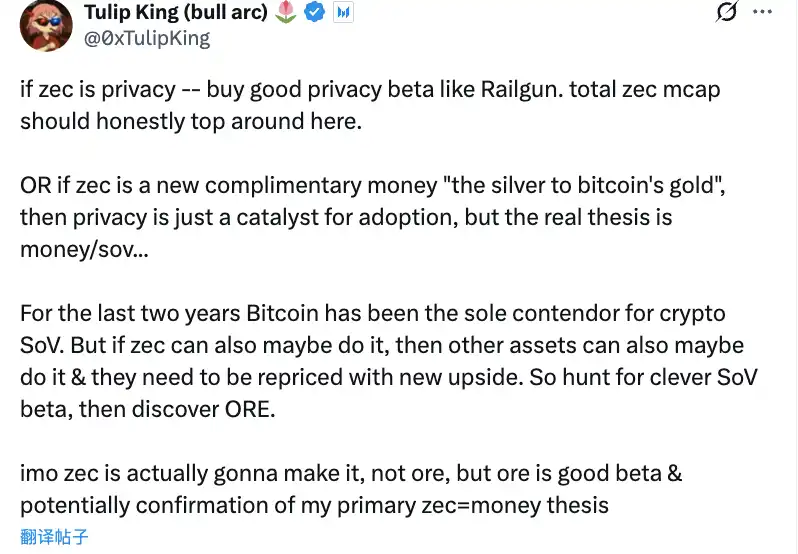
RAIL is a privacy protocol on Ethereum that can anonymize ETH, ERC-20 tokens, and NFTs. More importantly, Vitalik himself has used RAIL to anonymize millions of dollars in ETH and has natively integrated RAIL into his new project Kohaku (a wallet SDK), with MetaMask and OKX Wallet as partners. Fundamentally, RAIL charges a 0.25% fee for funds entering and exiting the privacy pool, and 77% of token supply is staked and locked for 30 days, making actual circulating supply much lower than headline numbers. This is a project with a clear business model and tokenomics, not just a speculative target.
But by mid-to-late October, a key market signal emerged: ZEC continued to soar while RAIL stagnated. This may indicate that ZEC’s rally is not just about privacy, but the market is repricing its monetary attributes and store-of-value function. In other words, privacy may be just a catalyst—the real narrative is “Can ZEC become Bitcoin’s silver?”—a narrative with a much higher ceiling.
Optimists believe ZEC has all the elements to become “Bitcoin Silver.” Technically, ZEC uses a proof-of-work (POW) mechanism, securing the network through hash power competition just like Bitcoin, which aligns more with the principle of “monetary neutrality” than proof-of-stake (POS)—no one can control the network simply by holding coins. ZEC’s total supply is capped at 21 million, a hard cap that is the core feature of a store-of-value asset, avoiding inflation dilution risk. More crucially, ZEC’s privacy feature is not a burden but an advantage: in a world of tightening regulation and fully transparent on-chain transactions, privacy is shifting from an “optional feature” to a “monetary necessity.” When every Bitcoin transaction can be traced and every address can be tagged, ZEC’s shielded transactions provide true fungibility—one of the most basic properties of money.
From a valuation perspective, optimists also point out that ZEC’s market cap is still extremely low compared to Bitcoin, implying huge revaluation potential. If ZEC is truly accepted by the market as a store-of-value asset, even capturing just 5-10% of Bitcoin’s share would mean several times upside. Historically, the silver-to-gold value ratio has fluctuated between 1:50 and 1:80; by the same logic, ZEC still has a huge valuation gap to close relative to Bitcoin.
Pessimists, however, offer a completely different perspective.
They argue that if ZEC’s value really lies in “money/store of value,” then the real challenger to Bitcoin is Ethereum, not ZEC.
Ethereum not only has smart contracts, a vast DeFi ecosystem, and institutional recognition, but more importantly, it already acts as “programmable money”—tens of billions of dollars in stablecoins circulate on Ethereum, and hundreds of billions are locked in Ethereum’s DeFi protocols. In comparison, ZEC, while offering privacy and a fixed supply, lacks ecosystem depth and use cases, making it more like a “single-function tool” than an “all-purpose currency.”
In this framework, pessimists are more optimistic about projects like Railgun. By enhancing Ethereum’s privacy, RAIL is actually improving ETH’s monetary properties. This means RAIL benefits not only from the privacy narrative but also from Ethereum’s monetary narrative—it stands on a larger, more mature ecosystem rather than trying to build a new monetary system from scratch.
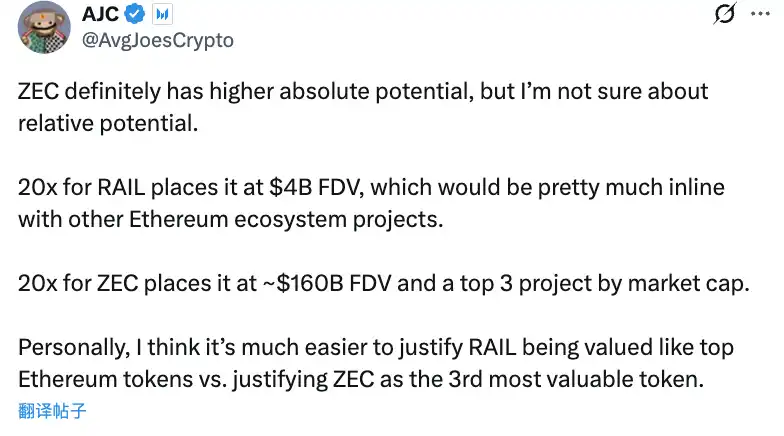
From a valuation perspective, the upside potential for the two is vastly different. If RAIL rises 20x, its fully diluted valuation (FDV) would reach $4 billion, which is in line with other top Ethereum ecosystem projects and is easy for the market to understand and accept. But if ZEC rises 20x, its FDV would reach $160 billion, making it the third-largest crypto asset by market cap, behind only Bitcoin and Ethereum. This requires the market to truly believe ZEC can stand shoulder to shoulder with Bitcoin and Ethereum—a very high bar.
This is not a question that can be settled by theoretical debate, but one that the market must answer with real action: In the next 12-24 months, can ZEC’s shielded pool balance continue to grow? Will institutions allocate ZEC through compliant channels like Grayscale? Will regulatory pressure crush ZEC or instead enhance its scarcity?
The answers to these questions will determine whether ZEC’s “Bitcoin Silver” narrative can stand, and also the sustainability and depth of this privacy coin rally.
Disclaimer: The content of this article solely reflects the author's opinion and does not represent the platform in any capacity. This article is not intended to serve as a reference for making investment decisions.
You may also like
$PING rebounds 50%, a quick look at the $PING-based launchpad project c402.market
c402.market's mechanism design is more inclined to incentivize token creators, rather than just benefiting minters and traders.
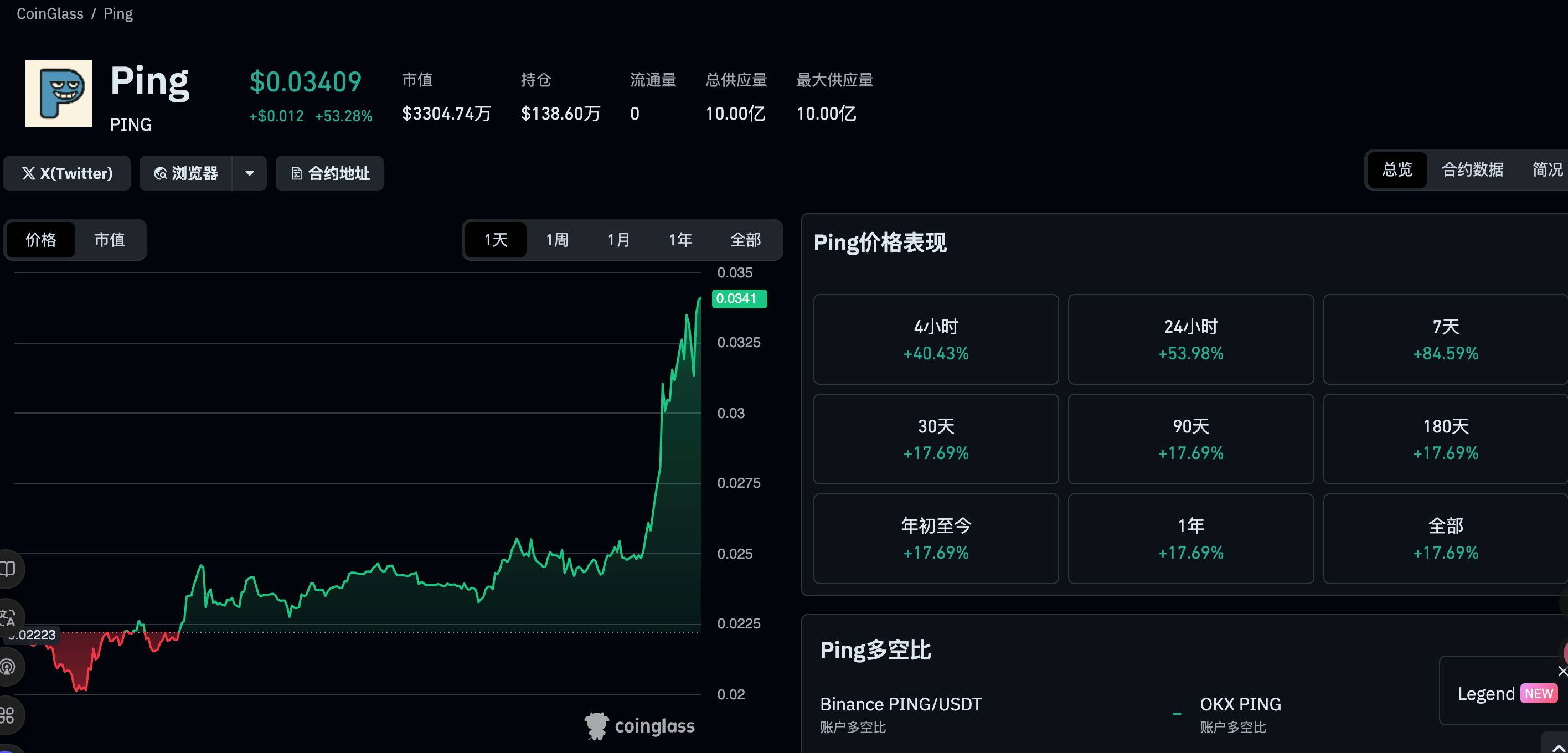
Crypto Capitalism, Crypto in the AI Era
A one-person media company, ushering in the era of everyone as a Founder.

Interpretation of the ERC-8021 Proposal: Will Ethereum Replicate Hyperliquid’s Developer Wealth Creation Myth?
The platform serves as a foundation, enabling thousands of applications to be built and profit.
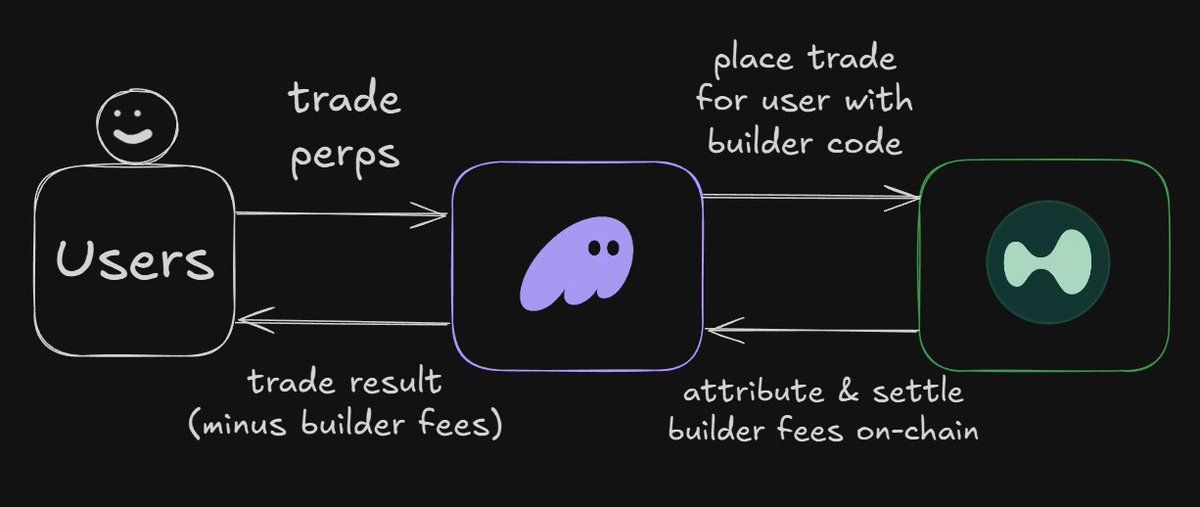
Data shows that the bear market bottom will form in the $55,000–$70,000 range.
If the price falls back to the $55,000-$70,000 range, it would be a normal cyclical movement rather than a signal of systemic collapse.
